Homemade Hazelnut Brittle Candy is a quick and easy treat that makes a great gift, perfect snack, or sweet topping.
Growing up my aunt always made peanut brittle at Christmas time. While delicious, there are so many other nut varieties to explore. At the top of my list were hazelnuts. Lightly toasted, nutty, creamy, and earth hazelnuts are the perfect partner for crisp, sweet, caramelized sugar.

Why you will love this recipe
- Hazelnut brittle is the perfect treat for sweet and salty lovers.
- There are so many ways to serve hazelnut brittle. Break it into pieces, dip it in chocolate, crush it in a blender and serve it ontop of ice cream.
- Easy to make hazelnut brittle makes an unexpected Christmas gift.
What is brittle?
Brittle is a type of candy. It is basically melted, caramelized sugar that has been heated to the hard crack stage, approximately 305 to 310 degrees Fahrenheit and aerated with baking soda. Caramelized sugar is acidic, when you add baking soda it reacts and produces gas creating a bubbly mixture that is then poured over nuts and spread out to cool.
As it cools, it hardens and becomes shiny. Once it has completely cooled, it is broken into smaller pieces. It can be eaten as is, added to other recipes, or used as a topping for ice cream or creme brulee.
What's the difference between brittle and praline?
Brittle is cooked to the hard crack stage while pralines are normally only taken up to the soft-ball stage. Pralines have a fudge-like or chewy texture, while brittle is hard and crunchy.
How to test sugar stages without a thermometer
Using a thermometer is the easiest way to monitor sugar's temperature as it cooks. If you don't have a candy or instant-read thermometer there is another way to test sugar's temperature using a glass of cold water.
Drop a teaspoon of the cooked sugar into a glass of cold water. Retrieve the sugar and examine it to determine the stage. The hotter the sugar the firmer it will be because more of the moisture has cooked out.
Use this chart below to determine what stage your sugar is at.
| Temperature | Sugar Stage | Uses |
|---|---|---|
| 223°F to 234°F | Thread: The sugar drips from a spoon and stretches into loose thin threads once it reaches the cold water. | Used for sugar syrups |
| 235°F to 240°F | Soft ball: The sugar forms into a sticky soft malleable ball in cold water but flattens when removed from the water. | Fudge, pralines, fondant, buttercream, and caramels |
| 245°F to 250°F | Firm ball: The sugar forms into a sticky ball in cold water, retains the ball shape when removed, but loses its shape when compressed. | Caramels, buttercream, nougat, marshmallows, Italian meringues, gummies, and toffees |
| 250°F to 264°F | Hard ball: The sugar forms into a hard sticky ball in cold water and remains a ball when removed. It keeps its shape when compressed, but feels sticky. | Caramels, nougats, divinity, and toffees |
| 270°F to 290°F | Soft Crack: The sugar forms into long threads in cold water. The threads are stretchy and slightly sticky when removed from the water. | Taffy, nougat, and butterscotch |
| 298°F to 310°F | Hard Crack: The sugar forms into long threads in cold water. The threads are stiff, brittle, and easily snap when removed from the water. | Hard candy, brittles, toffees, glazed fruit, and spun sugar |
| 320°F and up | Caramel: The sugar turns light golden yellow to dark amber. Nearly all water has been boiled out of the syrup. If sugar you continue to cook the sugar, it will burn and turn black | Pralines, brittles, and nougatine |

Ingredients
Hazelnuts: You can purchase already roasted and chopped hazelnuts or purchase whole hazelnuts and roast them yourself. The best price I have found is buying whole unroasted hazelnuts from the bulk bin at Fresh Thyme.
White Granulated Sugar: Sugar is caramelized and cooked until the hard crack stage, approximately 305 to 310 degrees Fahrenheit. That means that once the sugar cools it will solidify and snap into pieces easily. It should not be sticky or bendy.
Light Corn Syrup: Corn syrup helps to prevent the sugar from crystallizing as it melts.
If you don't have corn syrup, you can substitute an equal amount of honey, light molasses, agave, or brown rice syrup. Keep in mind that making a substitution will give the brittle a slightly different taste and texture.
Water: Water is used to dissolve the sugar.
Unsalted Butter: Butter helps to tenderize the candy and adds its own rich flavor. When baking I prefer to use unsalted butter so that I can control the amount of salt that is used.
Baking Soda: The addition of baking soda creates millions of microscopic bubbles in the candy. These bubbles make the caramelized sugar "brittle" so that it breaks when you bite it rather than being so hard you must suck on it like toffee or a lollipop.
Be prepared once the baking soda has been added the syrup will begin to foam, often reaching two to three times its original volume.
Be sure to remove the caramelized sugar from the heat before adding the baking soda. Otherwise, it will foam up and overflow from the saucepan.
Vanilla: For the best flavor use pure vanilla extract not imitation vanilla.
Flaky Sea Salt: Before it hardens completely, I like to top my brittle with a sprinkle of flaky sea salt which provides a nice contrast to the sweet brittle. Maldon sea salt is one of the best.
Equipment
Thermometer: A thermometer is the easiest way to be sure you have heated the sugar to the correct temperature. You can purchase a candy thermometer that clips to the side of your saucepan or use an instant-read thermometer like the Thermopen from Thermoworks. The Thermopen is handy because it can also be used to check the temperature of baked goods and meat.
Large Heavy Bottomed Sauce Pan: A heavy-bottomed saucepan evenly distributes the heat reducing the likelihood that portions of the sugar will burn. I prefer to use a light-colored saucepan which allows me to easily monitor the color of the sugar. You can also use an enameled dutch oven.
Pastry Brush: A pastry brush is useful to brush any stray sugar crystals from the sides of the saucepan. I am partial to silicone pastry brushes because I don't have to worry about leaving stray bristles behind.
Baking Sheet: After heating the sugar it is poured onto a baking sheet to cool.
Parchment Paper: Parchment paper is great for lining your baking sheet ensuring that the brittle does not stick and making clean up really easy. I like these pre-cut parchment paper sheets that are available from Amazon.
Pam: Pam is the easiest way I have found to quickly grease the parchment paper.
Rubber Spatula: A rubber spatula is a great tool for spreading the brittle into an even layer. Spray with cooking spray to keep the brittle from sticking to it. This one is my favorite. It is comfortable to hold and isn't too floppy.
How to toast hazelnuts
Toasting hazelnuts intensifies their flavor. To toast hazelnuts:
- Preheat oven to 350°F with a rack in the topmost position.
- Place the hazelnuts on a sheet pan and toast for 15 to 20 minutes until fragrant, stirring every 5 minutes to prevent burning.

How to remove hazelnut skins
Toasting the hazelnuts also makes them easier to peel. To peel toasted hazelnuts:
- Transfer toasted hazelnuts to a clean dishtowel. Rub and roll them around between your hands to remove the skins.
- Remove the hazelnuts from the dishtowel and roughly chop. I like a variety of sized pieces.
How to make brittle
Once the hazelnuts have been toasted and peeled, you are ready to make the brittle.
Line a baking sheet with a Silpat or oiled parchment paper.
In a large saucepan, combine the sugar, corn syrup, and water. Attach your candy thermometer to the edge of the saucepan, and make sure it is submerged in the liquid, but not touching the bottom of the pot.
Heat the sugar mixture over medium-low heat. If you see sugar clinging to the sides of the pan, use a pastry brush dipped in water to brush down the sides of the pan. DO NOT STIR the sugar mixture. You may swirl the pan gently about halfway through the cooking time to incorporate any uncooked sugar.


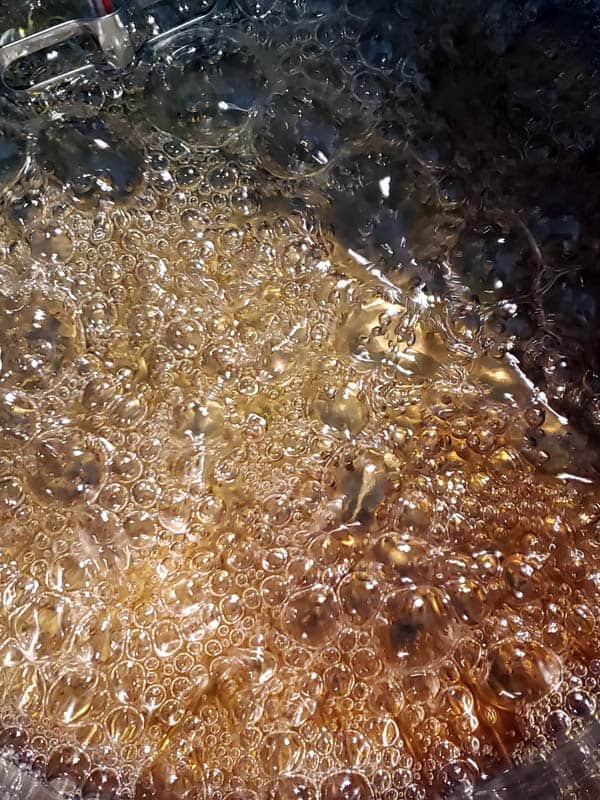
Simmer without stirring until the caramel is 305 degrees Farenheight and deep amber in color. Roughly 10 to 15 minutes.
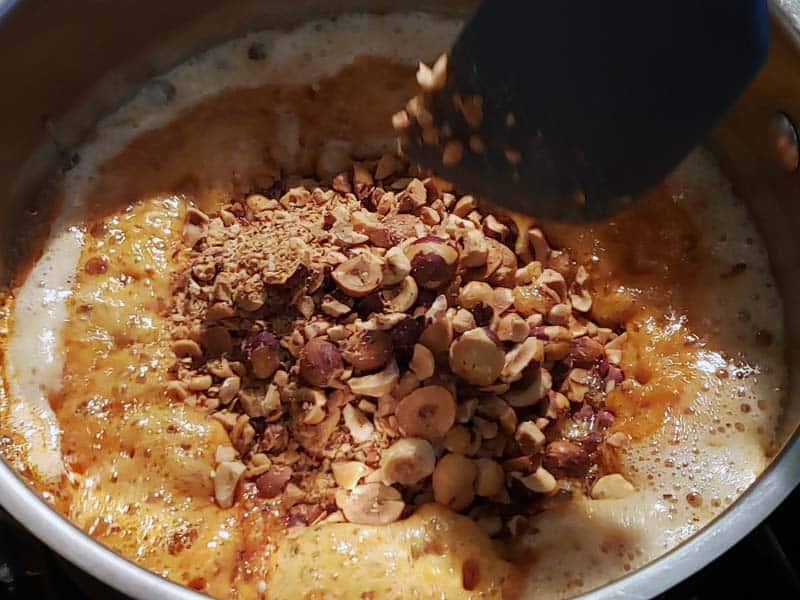
Remove the saucepan from the heat and add the hazelnuts, butter, baking soda, and vanilla. When the baking soda is added the syrup will begin to foam, often reaching two to three times its original volume. Stir until all of the hazelnuts are evenly coated with the syrup.
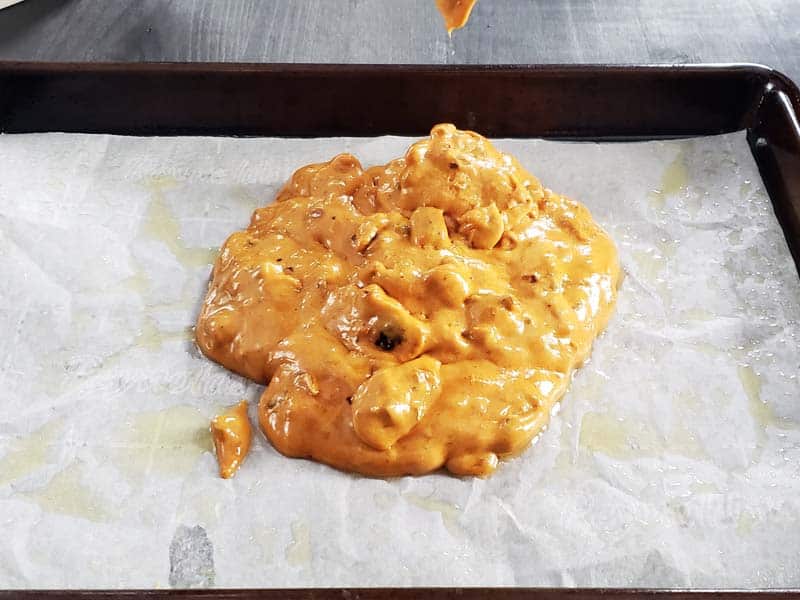

Pour the hazelnut mixture onto the prepared baking sheet. Use an oiled rubber spatula to spread the mixture into an even layer about ½ inch thick.
Sprinkle with sea salt and allow the brittle to cool for at least 30 minutes.

Once the brittle has hardened break it into pieces.
Frequently asked questions
Brittle can turn out chewy if it wasn't heated to a high enough temperature. Sugar for brittle needs to be heated to the hard crack stage or between 305 and 310 degrees Fahrenheit.
If your brittle was hard when you first made it but then became chewy, moisture is most likely the cause. High humidity can cause brittle to soften.
After pouring the sugar onto the baking sheet it should cool and fully harden in 20-30 minutes. Allow the brittle to cool at room temperature. Do not refrigerate brittle. The moisture in the refrigerator could keep it from fully hardening.
Because brittle is hard candy so moisture is the enemy. Do not store brittle in the refrigerator. It is best stored in an airtight container at room temperature for 6-8 weeks. If you are worried about the brittle sticking together you can separate each layer with a piece of parchment paper.
Brittle can also be frozen. Freeze brittle in an airtight container for up to three months.
Sugar quickly dissolves in boiling water. The easiest way to clean your pan is to boil some water in it. I will also hold any utensils I used in the boiling water until the sticky sugar has dissolved.
Stella Parks writes about an interesting technique on Serious Eats. In the article, she suggests boiling other ingredients like heavy cream or coffee in the pan to dissolve the sugar and using that liquid as the base for another recipe.
Variations
Try substituting different types of nuts. Peanuts are a popular choice but cashews, macadamias, walnuts, and almonds will work well too.
After the brittle has hardened try drizzling it with some melted chocolate for an extra special treat.
Tips
- Prep your baking sheet and ingredients before you begin caramelizing the sugar. Once the sugar begins to caramelize the process moves quickly.
- Don't stir the sugar. Stirring the sugar will encourage sugar crystallization which will make your brittle grainy.
- Don't wander away from the sugar while it is caramelizing. It will go from the perfect shade of brown to burned quickly.
- Melted sugar is extremely hot! In fact, sugar has a higher boiling point than water. Don't touch the melted sugar and be careful to not drop any on your skin. I usually wear oven mitts when pouring the melted sugar onto the baking pan. Don't use your fingers to taste or stop drips.
📖 Recipe

Homemade Hazelnut Brittle Candy
Equipment
- thermometer candy or instant-read
- large sauce pan heavy bottomed
- parchment paper
Ingredients
- 1 cup hazelnuts
- 1 cup granulated white sugar
- ½ cup light corn syrup
- ¼ cup water
- 2 tablespoons unsalted butter
- 1 teaspoon baking soda
- 1 teaspoon vanilla extract
- sea salt to sprinkle on top
Instructions
Toasting the Hazelnuts
- Preheat oven to 350°F with a rack in the topmost position.
- Place the 1 cup hazelnuts on a sheet pan and toast for 15 to 20 minutes until fragrant, stirring every 5 minutes to prevent burning.
- Transfer toasted hazelnuts to a clean dishtowel. Rub and roll them around between your hands to remove the skins.
- Remove the hazelnuts from the dishtowel and roughly chop. I like a variety of sized pieces.
Making the Brittle
- Line a baking sheet with a silpat or oiled parchment paper.
- In a large saucepan, combine the 1 cup granulated white sugar, ½ cup light corn syrup, and ¼ cup water. Attach your candy thermometer to the edge of the saucepan, and make sure it is submerged in the liquid, but not touching the bottom of the pot. Heat the sugar mixture over medium-low heat. If you see sugar clinging to the sides of the pan, use a pastry brush dipped in water to brush down the sides of the pan. DO NOT STIR the sugar mixture. You may swirl the pan gently about halfway through the cooking time to incorporate any uncooked sugar.
- Simmer without stirring until the caramel is 305 degrees Farenheight and deep amber in color. Roughly 10 to 15 minutes.
- Remove the saucepan from the heat and add the hazelnuts, 2 tablespoons unsalted butter, 1 teaspoon baking soda, and 1 teaspoon vanilla extract. Stir until all of the hazelnuts are evenly coated with the syrup.
- Pour the hazelnut mixture onto the prepared baking sheet. Use an oiled rubber spatula to spread the mixture into an even layer about ½ inch thick. Sprinkle with sea salt and allow the brittle to cool for at least 30 minutes.
- Once the brittle has hardened break it into pieces.
Notes
- Prep your baking sheet and ingredients before you begin caramelizing the sugar. Once the sugar begins to caramelize the process moves quickly.
- Don’t stir the sugar. Stirring the sugar will encourage sugar crystallization which will make your brittle grainy.
- Don’t wander away from the sugar while it is caramelizing. It will go from the perfect shade of brown to burned quickly.
- Melted sugar is extremely hot! In fact, sugar has a higher boiling point than water. Don’t touch the melted sugar and be careful to not drop any on your skin. I usually wear oven mitts when pouring the melted sugar onto the baking pan. Don’t use your fingers to taste or stop drips.
Nutrition
More dessert recipes
- Honeycomb Candy
- Easter Candy Charcuterie Board
- Hazelnut Brownies
- Homemade Apple Cake
- Peanut Butter Chocolate Chip Caramel Cookies
Thanks for Reading!
If you try this recipe, let me know! Leave a comment and rate it below! You can also snap a picture and post it on Facebook or Instagram be sure to tag me @RaspberriesandKohlrabi.
Subscribe to get more recipes and tips by email.



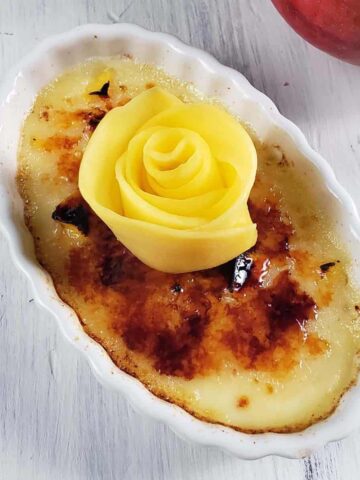
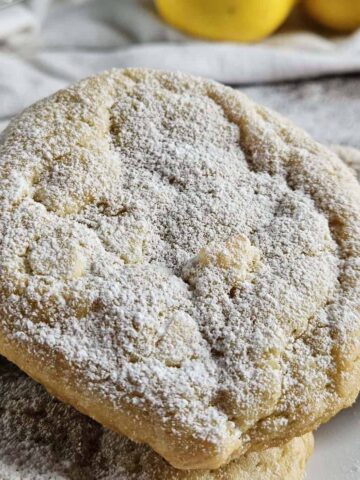
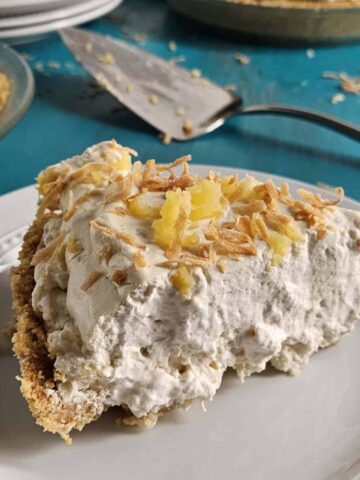
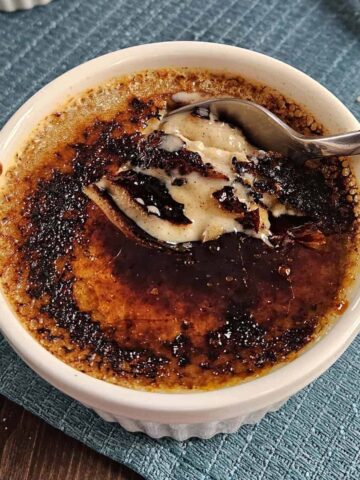
Comments
No Comments